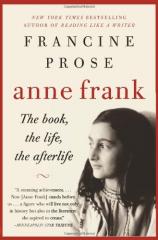Anne Frank: The Book, the Life, The Afterlife
Review
Anne Frank: The Book, the Life, The Afterlife
When originally released in the United States, Anne
Frank’s THE DIARY OF A YOUNG GIRL met with unmitigated
enthusiasm, inspiring everyone who read it with its call to
understanding and forgiveness. In a new era, civilized people
tolerate the intolerable and allow the same book to be labeled
false and pornographic by a vocal few. Yet still the book inspires,
speaking a universal language with a wisdom that exceeds the years
of its writer, teenaged journalist Anne Frank.
This is a book about the book --- a highly favorable critique of
its remarkable content and style, and the story of how it came to
be. Anne, as it is famously known, was the child of a prominent
Dutch Jew, Otto Frank, who converted the attic of his small factory
into a cramped hiding place for his family when the deportation of
Jews began to take place during the Nazi regime. For two years, the
small group woke up, interacted during the night, slept during the
day, and successfully kept themselves from discovery with the help
of Otto’s trusted factory staff, who brought in supplies and
maintained total secrecy. At some point, however, their ruse was
discovered and the Nazis finally ripped the Frank family apart.
For the average teenage girl the confining conditions would have
been intolerable, and had Anne not been a most unusual teenager, it
easily could have been hell. But Anne’s rare talent for
writing helped her focus most of her time on composing the story of
the everyday events she observed in the attic, along with her
musings about love and war. She understood that her suffering was
inconsequential compared to what was happening to her fellow Jew
and Dutch friends outside, and at times she would even
optimistically reflect on nature and life and celebrated small
moments of beauty in the pages of her book.
Award-winning fiction author Francine Prose makes the compelling
case that Anne Frank was no ordinary teen and no ordinary diarist.
A writer from early childhood, Anne, who was fierce in protecting
the privacy of her document, continually revised her
“diary” much like an adult author would as she intended
it for publication after the war. And although the diary would
eventually reach its way to readers around the world, it was a
posthumous publication for Anne. Believing her parents to be dead
(in reality, her father was able to survive the camps) and watching
her older sister die pitifully in the camp “infirmary,”
Anne passed away a few scant weeks before the liberation of
Bergen-Belsen from a combination of typhus, starvation and a broken
heart.
Eventually, her father found her diary when he returned to the
attic after the war and saw it for the gem that it was. Along with
the little book, there were many pages of revisions and additions,
so he devoted himself to editing it into a cohesive whole.
Transformed into the book we now know so well, the cover was
adorned with a picture of Anne’s smiling face, an image that
has become an international icon of hope. Prose gives us the back
story of the long process of bringing the diary to publication, to
the stage and screen, and the serious, often litigious squabbles
for the book’s rights. Despite the arduous task in bringing
the work to the masses, it was all worth the trouble as it became a
beacon for tolerance upon publication.
But tragically, like all beautiful things, it was eventually
tainted. The book was marked for destruction by Neo-Nazis and
Holocaust deniers; if Anne’s story is true, then their
twisted beliefs would be impossible to defend. Otto Frank, inspired
by his young daughter’s spirit, seemed to feel that he needed
to uphold her truth by forgiving those who wanted to wrest the
story from him, those who claimed he had written the book himself
for profit, those who declared that the book was a cesspool of
Semitic sex and pedophilic fantasies, and those who wanted the
world to believe that Anne never lived and never died. Frank
remained curiously passive toward the hate-mongering critics, yet
obsessively devoted to the cause of spreading Anne’s story,
keeping it alive for all times.
Reading this book brings back memories of one’s first
reading of THE DIARY OF A YOUNG GIRL, a literate paean to the
idealism of youth amidst the terror and bleak reality of war and
hate. It will undoubtedly prompt us to re-read young Anne’s
diary as a multi-layered work --- not just the chronicle of
long-ago events told by a bright youngster, but as a brilliant work
of art given to the world by a rare, lost genius.
Reviewed by Barbara Bamberger Scott on December 22, 2010
Anne Frank: The Book, the Life, The Afterlife
- Publication Date: October 1, 2010
- Genres: Literary Criticism, Nonfiction
- Paperback: 336 pages
- Publisher: Harper Perennial
- ISBN-10: 0061430803
- ISBN-13: 9780061430800





